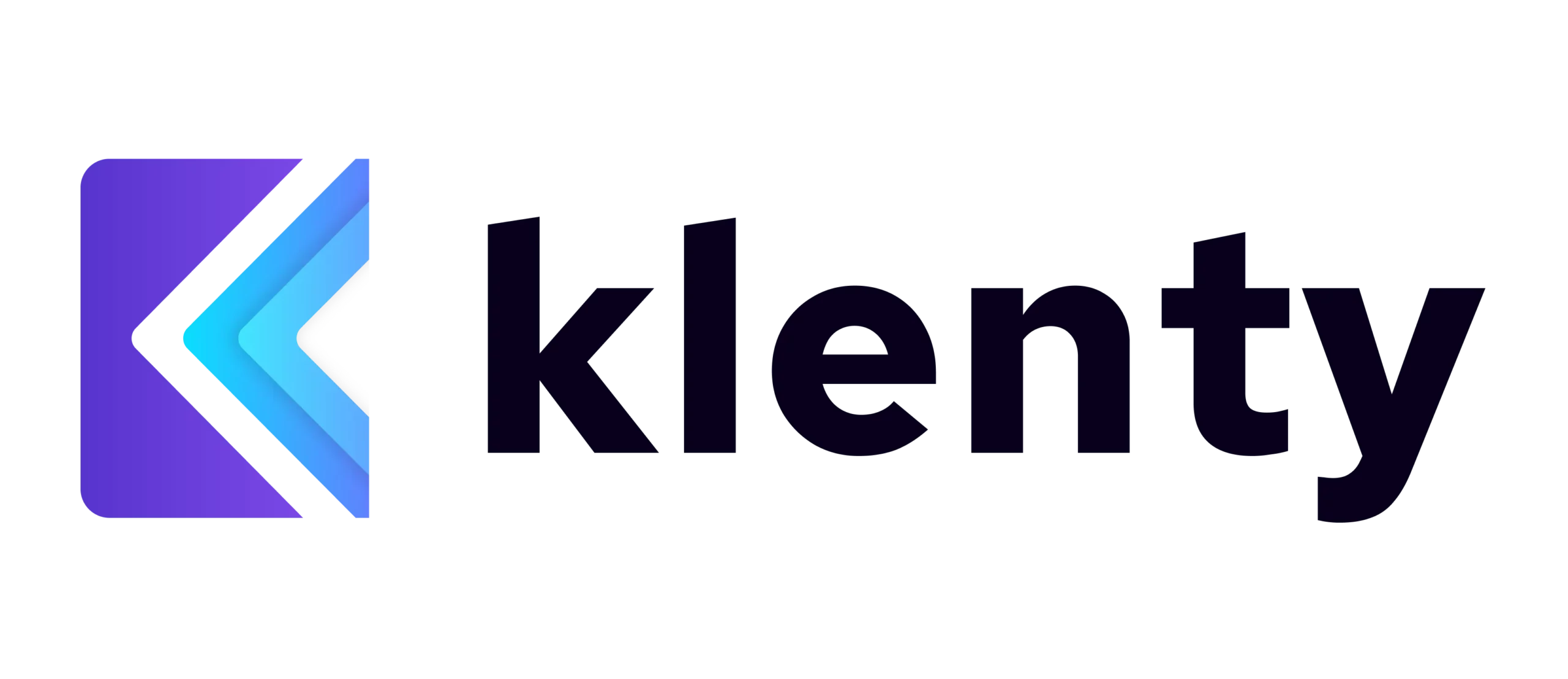Research shows successful cold calls last almost twice as long as unsuccessful cold calls.
Even by general observation, you can see how calls with a negative outcome tend to end soon, and calls having a successful outcome (like, getting a meeting booked) mostly have longer durations.
But how long should a cold call last for it to be a successful one?
We decided to get to the bottom of this.
We studied 25,000 cold calls.
To confirm our observation about successful calls having longer durations, we picked 25,000 cold calls made by reps across different companies from our database at Klenty.
For these calls, we looked into the respective durations and their outcomes.
Next, we grouped the outcomes into one of these 8 categories:
- Positive: Prospect shows curiosity and has a back-and-forth conversation with the rep.
- Meeting booked: Prospects agreeing to a meeting.
- Negative: Prospect explicitly tells not to call them again or if they’re not a good fit.
- Neutral: Neither positive nor negative, like the call getting disconnected.
- Contact later: Prospect asking the rep to call them again.
- No answer: The rep’s call remains unanswered.
- Left voicemail: Reps leaving voicemail as there’s no answer.
- Wrong contact: SDR reaches the wrong person.
In terms of duration, there were calls that lasted for just a second, while some calls went beyond 15 minutes.
To get a better understanding, we divided the 25,000 calls into 8 different slots:
| Duration slots (in seconds) | Number of calls in each slot |
| 1-30 | 7092 |
| 31-60 | 5753 |
| 61-90 | 3803 |
| 91-120 | 2411 |
| 121-150 | 1468 |
| 151-180 | 989 |
| 181-300 | 1,863 |
| 300+ | 1,621 |
What does the data say?
For this study, we define a “good call” as a cold call having an outcome as either positive or meeting booked.
So, in each of the slots, we looked into the shares of the outcomes. Based on our 30-second slots, we analyzed the first 3 minutes, wherein there are 2 slots per minute.
First minute (1-60 seconds)
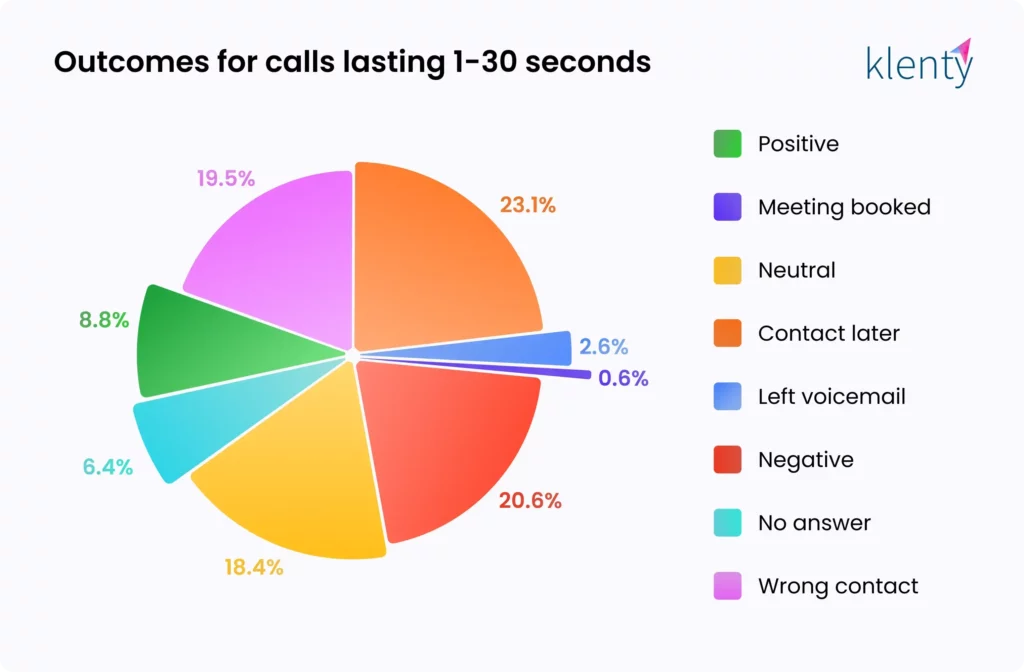
In the first 30 seconds, we can see that the share of positive and meetings booked outcomes are only 8.8% and 0.6%, respectively. On the other hand, the share of calls with negative (20.6%), contact later (23.1%), and wrong contact (19.5%) occupy a larger share.
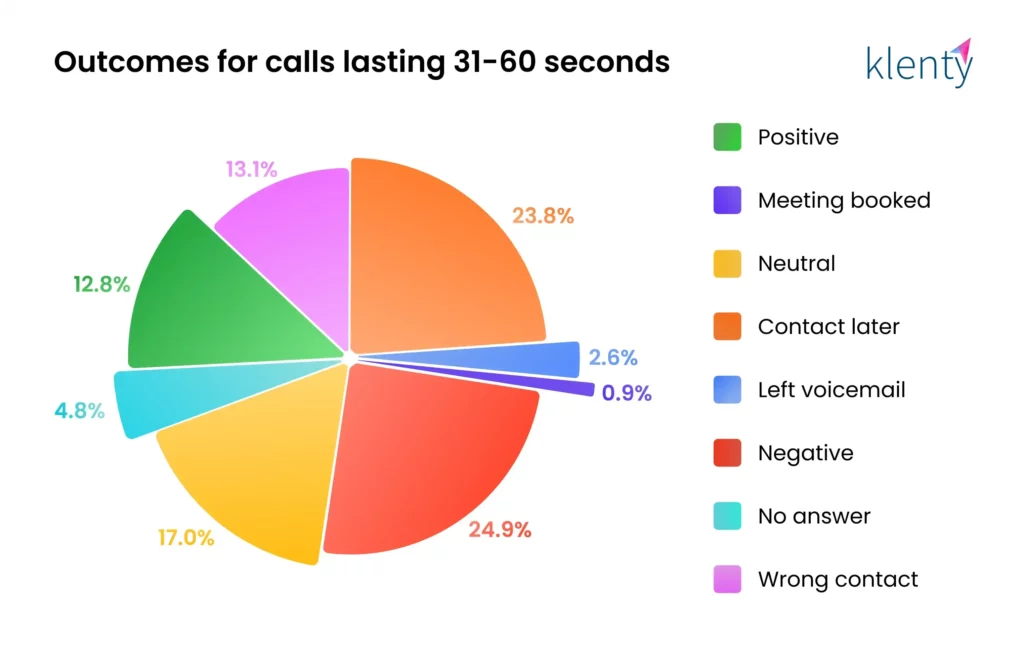
For the second slot, there’s a slight improvement for the positive (12.8%) and meetings booked (0.9%) outcomes, but the negative calls also go up (24.9%). Also, only slight changes can be seen in the shares of calls with contact later (23.8%) and wrong contact (13.1%).
Interpretation: Our study reveals that the average chance of having a good call within the first minute is quite slim—9.4% in the first 30 seconds and 13.7% if the call lasts between 31 and 60 seconds.
This is obvious, as prospects who’re not interested in your offer don’t tend to stay on the phone with you for long. Given the shares of calls with negative or contact later outcomes, these calls mostly last for less than a minute.
Second minute (60-120 seconds)
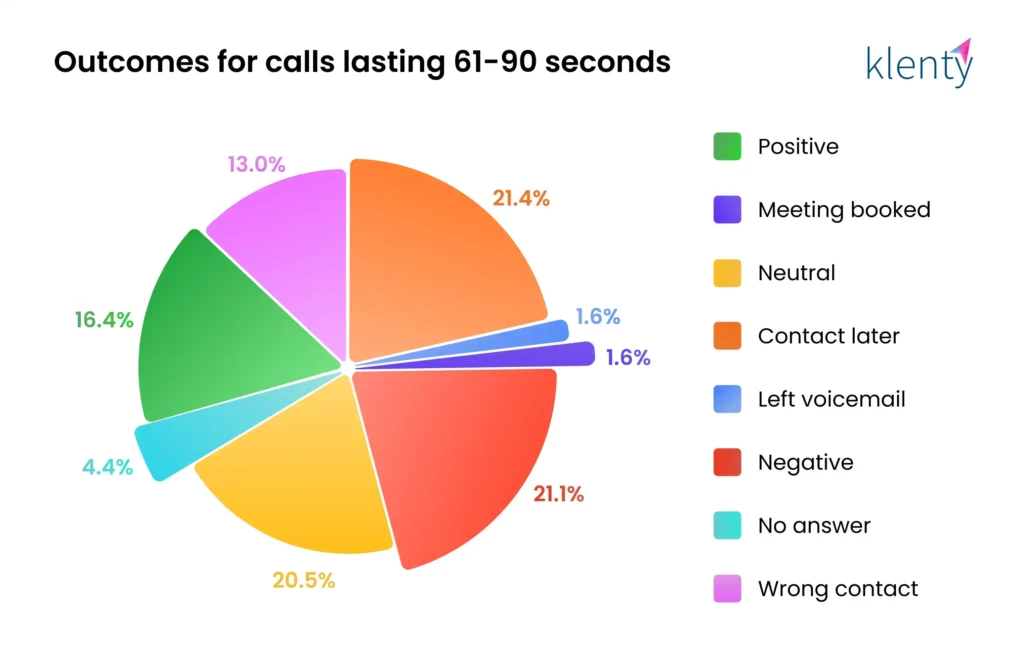
For cold calls that last between 61 and 90 seconds, we see that the calls with positive outcomes increase to 16.4% and meeting booked calls to 1.6%. Calls with negative outcomes dip to 21.1%.
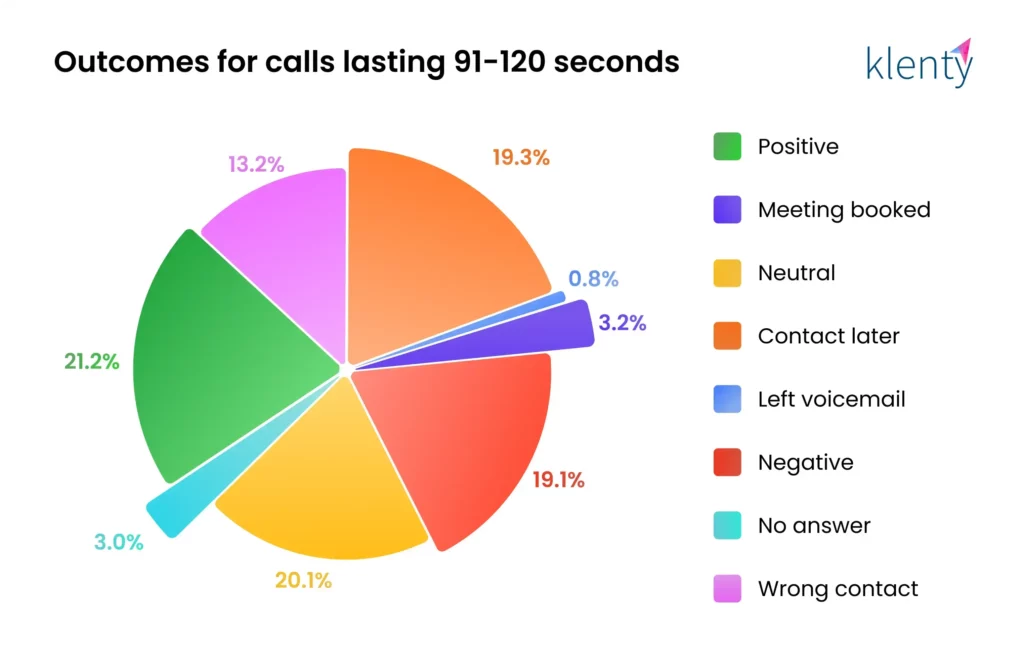
As we look at the calls that last between 91 and 120 seconds, we see the share of positive calls increasing to 21.2%, while calls where the outcome was a booked meeting have a 3.2% share. Similarly, calls with negative outcomes dip below the 20% mark to 19.1%.
Interpretation: A cold call that lasts between 1.5 and 2 minutes has a 24.4% chance of being a good call (combining 21.2% positive and 3.2% meeting booked calls).
Third minute (120-180 seconds)
In both of these slots, we can see that the share of calls with positive and meeting booked outcomes goes up significantly.
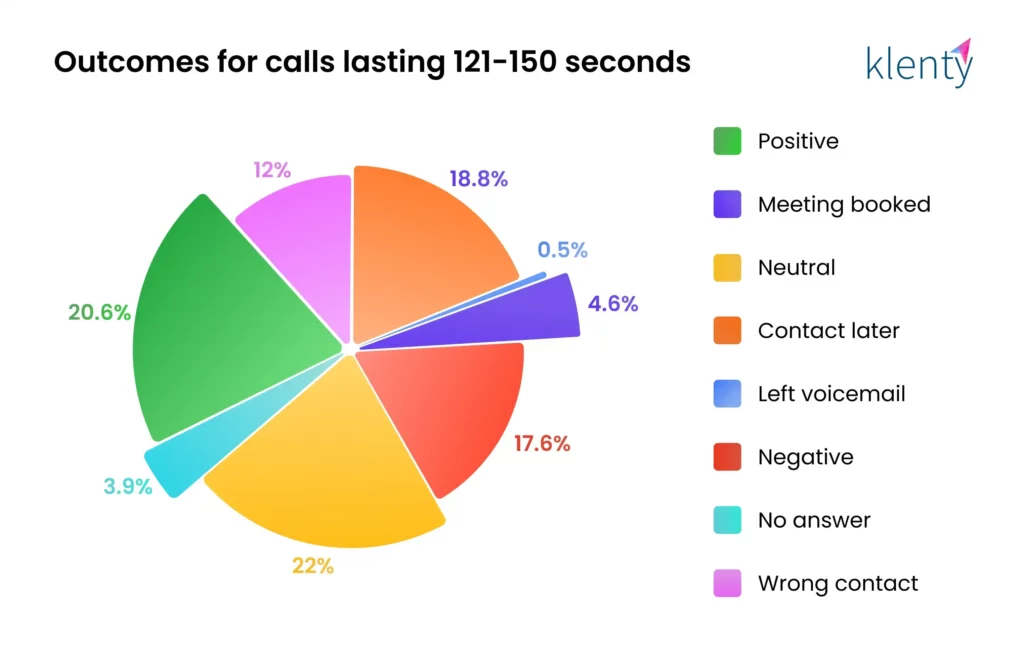
Positive calls are 20.6%, and meetings booked calls are 4.6% in the 121-150 seconds slot, while the shares of negative, contact later, and wrong contact calls are 17.6%, 18.8%, and 12%, respectively.
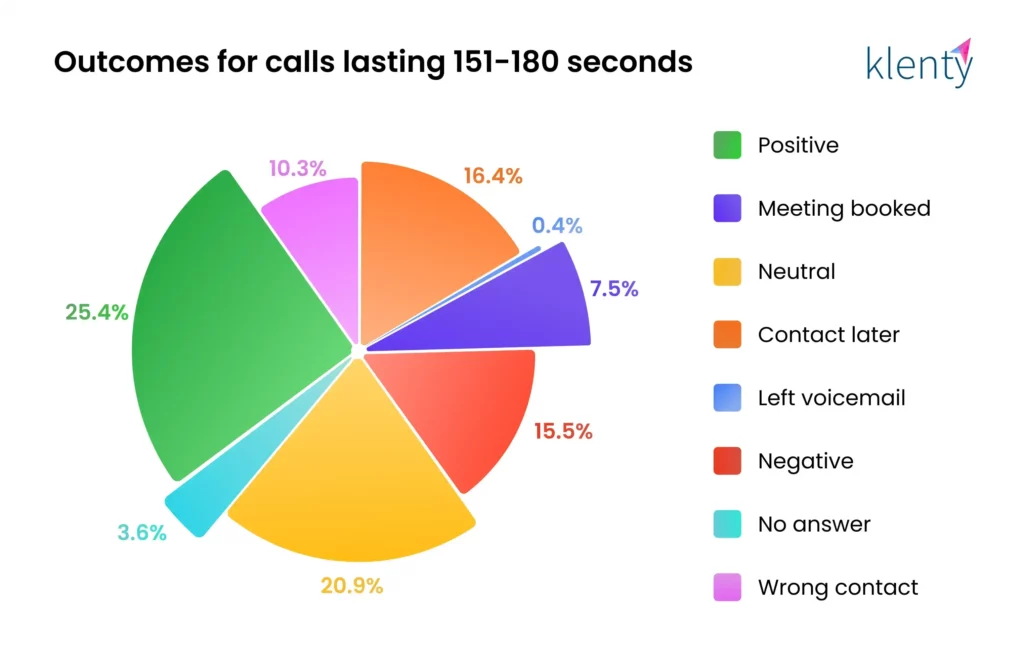
The trend continues in the 151-180 seconds slot, as the share of positive calls go up to 25.4% and meetings booked calls have a share of 7.5%. Shares of calls with negative (15.5%), contact later (16.4%), and wrong contact (10.3%) also decreased.
Having analyzed 21,516 calls so far, which is over 85% of the 25,000 calls, we wanted to check if this trend holds true for the remaining calls as well.
Beyond 3 minutes
We grouped the remaining 3,484 calls, whose individual durations exceed 3 minutes, into 2 slots: 181-300 seconds and 300+ seconds.
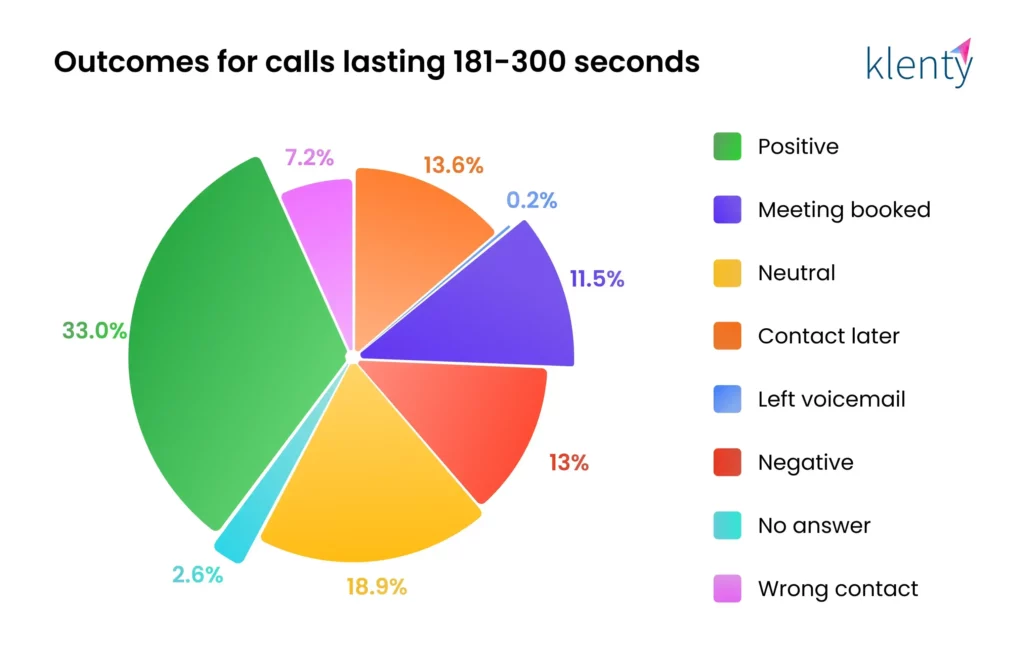
Among the calls that lasted between 181 and 300 seconds (3 to 5 minutes), 33% had a positive outcome, and 11.5% had meetings booked. The share of calls with negative (13%), wrong contact (7.2%), and contact later (13.6%) outcomes are definitely lower than the previous duration slots.
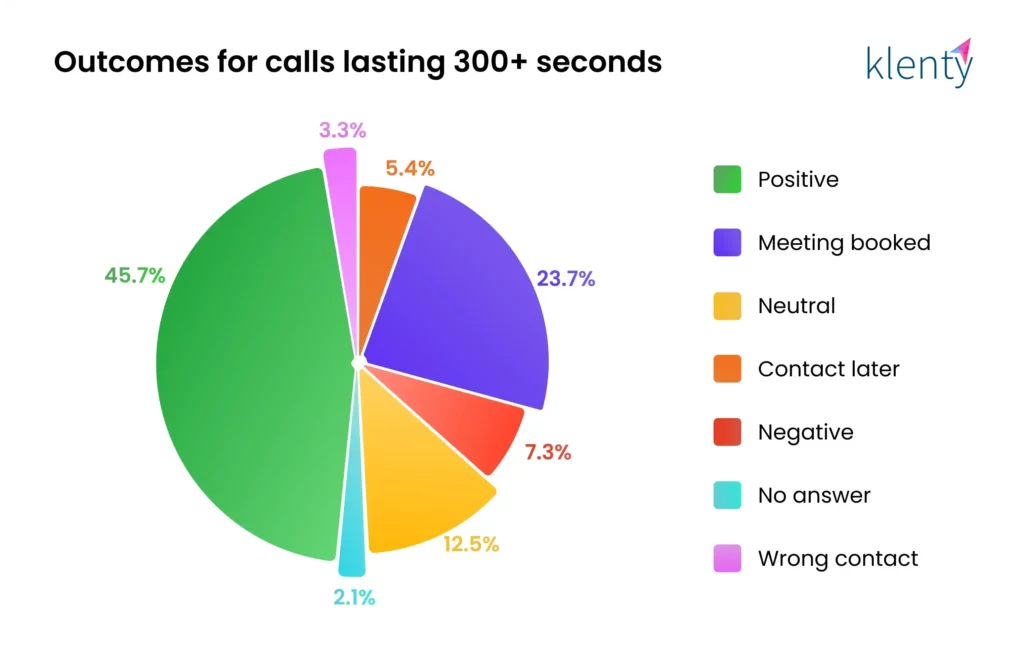
However, things become much clearer in the final slot that comprises calls lasting beyond 300 seconds (5 minutes). Almost half of the calls here (45.7%) have a positive outcome, while nearly a quarter (23.7%) of the calls resulted in booked meetings. Calls with undesirable outcomes—negative (7.3%), wrong contact (3.3%), contact later (5.4%), no answer (2.1%) and neutral (12.5%)—occupy only around 30% of the total calls in this slot.
So, our analysis has proven one thing beyond doubt:
The chance of having a good call is directly related to the call duration.
In other words, the longer your call duration, the higher your chances of booking meetings.
Okay, but we still haven’t arrived at how long the duration should be for calls.
To get a better picture of the relationship between durations and call outcomes, here’s what we did:
- We took the 8 duration slots and divided the last 2 slots further to have 12 duration slots in total. The 6 new slots (in seconds) are 181-210, 211-240, 241-270, 271-300, 301-600 and 600+.
- Next, for each of these duration slots, we calculated the percentage of good calls—that is, how many calls have either a positive or meeting booked outcome in a given slot.
Here’s what we arrived at.
| Duration slots (in seconds) | Percentage of good calls in each slot |
| 1-30 | 9.36% |
| 31-60 | 13.73% |
| 61-90 | 18.01% |
| 91-120 | 24.39% |
| 121-150 | 25.14% |
| 151-180 | 32.86% |
| 181-210 | 37.90% |
| 211-240 | 43.82% |
| 241-270 | 48.47% |
| 271-300 | 56.79% |
| 301-600 | 66.06% |
| 600+ | 77.40% |
By plotting a graph based on these values, we can see how the chances of having a good outcome for cold calls increase almost linearly with time.
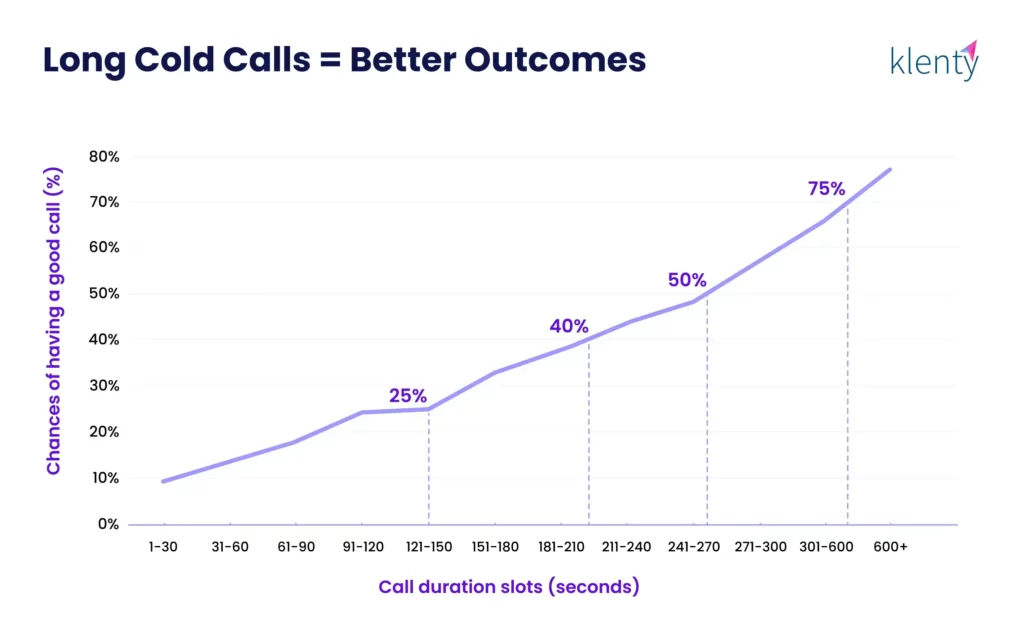
How long should a cold call last?
Based on our analysis so far, we make the following conclusions:
- Calls must last at least 90 to 150 seconds or around 2 minutes to have a 25% chance of being a good call.
- Calls that last between 150 to 240 seconds or between 2.5 minutes and 4 minutes have around 40% chance of having a good outcome.
- If you want over 50% chance of your cold call having a good outcome, your call duration should be at least 5 minutes.
- Calls that last more than 10 minutes or 600 seconds have a possibility of over 75% to have a good outcome.
As you can see, there’s no one answer to this question. For an activity like cold calling that has several variables, our in-house study tried to approximate the chances of having a good cold call based on different durations.
So, what can you do to maximize your cold calling duration?
4 battle-tested practices to engage prospects during cold calls
After seeing the impact of the duration of cold calls on its outcome, now comes the question: What can you do to engage prospects during cold calls to improve the time and quality of your conversation?
Here are 4 best cold calling practices that our reps at Klenty have evolved through the grind of making tens of thousands of cold calls:
- Clearly state that this is a cold call. This sets the prospect’s expectations for the call. By acknowledging that you’re intruding into their time, you bring transparency to your conversation, which makes them trust you better.
- Use permission-based openers with specific duration. Since this is a cold call, ask for the prospect’s permission before proceeding with your pitch. This shows politeness on your part and the respect you have for their time.
To convince the prospect to listen to you, ask for a specific duration, like: “Do you have 30 seconds to hear how (product) can (solve pain point)?"
- Don’t ask questions that you can find answers through research. It isn’t enough that you need to do research before a call—you have to show the prospect that you’ve done research.
Questions like “What CRM do you use?” or “How many members are there in your team?” can annoy prospects because they would not be comfortable revealing such information to a stranger.
Instead, say something like: “I came across your LinkedIn post about {CRM name}.” or “I noticed you have hired 2 new members to your team.” This will show prospects that you’ve done your research, and they would want to keep the conversation going.
- Match your prospect’s energy. No 2 prospects will be the same. Some might like to have a chat about the weather or the previous night’s game, while others would have a no-nonsense approach and get down to the details ASAP.
So, always tailor your conversation based on the prospect’s conversation style to have a positive outcome call.
And finally…
As our study shows, duration has a direct impact on your call outcome. So, reps striving to extend their call duration can reap positive results.
To start with, using a cold call script can boost your confidence and help you engage prospects better during cold calls.
If you’re looking to hone your cold calling chops further, check out our 20 cold calling tips from 8 quota-crushing sales reps we spoke to.
Go out there and have quality conversations with your prospects to book more meetings!
